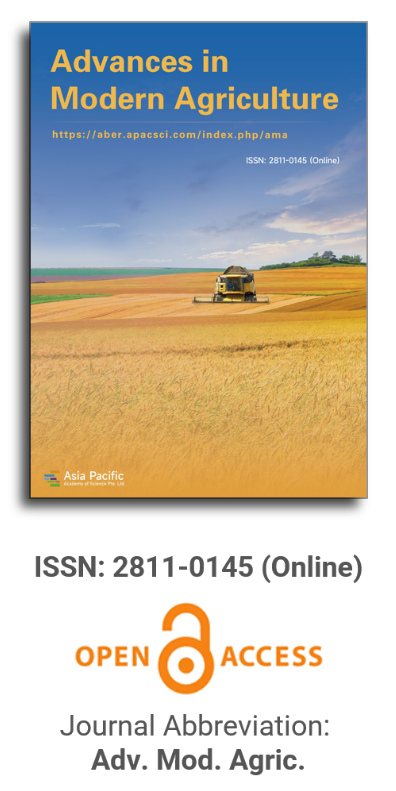


A prolonged release system (SLIP) of urea powder encapsulated in a wheat gluten matrix was investigated as a sustainable substitute for use in agriculture with the goal of lowering nitrogen losses in the soil. Thermogravimetry (TGA), Fourier Transform Infrared Spectroscopy (FT-IR), and Scanning Electron Microscopy (SEM) were the methods used to characterize SLIP. The urea release kinetics in water were then assessed. Very porous structures were produced, the thermal stability of SLIP was noted, and interactions between urea and gluten proteins through hydrogen bonds were verified. According to the kinetics, urea was released at a high rate (38%) in the first ten minutes and reached the diffusion equilibrium (86.35%) after 36 hours. There is a chance that urea SLIP will be employed as a sustainable substitute in agriculture.
To explore the light intensity suitable for the growth of purple leaf lettuce seedlings in plant factories and greenhouses, the effects of light intensity of 6000, 12,000, 18,000, 24,000, and 30,000 lx on growth morphology, nutritional quality, photosynthetic pigment, and photosynthetic characteristics of purple leaf lettuce seedlings were studied with ‘Beizisheng 3’ as the experimental material under the condition of white light quality unchanged. The results showed that under a light intensity of 30,000 lx, purple leaf lettuce seedlings grew well, and the biomass, chlorophyll a content, chlorophyll b content, carotenoid content, total chlorophyll, soluble protein content, soluble sugar content, vitamin C content, anthocyanin content, net photosynthetic rate, transpiration rate, and stomatal conductance were the largest, while the nitrate content and intercellular CO2 concentration were the lowest. However, chlorophyll b content, carotenoid content, soluble protein content, and transpiration rate had no significant difference compared with those under 24000 lx light intensity, and the plant height was the highest under 24,000 lx light intensity. Under the condition of white light quality, the most suitable light intensity for the growth of purple leaf lettuce seedlings is 30,000 lx.
Avocado is a traditional fruit in the diet of Ecuadorians and requires proper crop handling to guarantee high production. Implementations of new technological alternatives, such as spectroscopy indexes that correlate with each other, will optimize avocado crop management. This research validated the use of red band and near infrared-based plant indices with leaf nitrogen content. The plant indices used were normalized differential vegetation index (NDVI) and transformed vegetation index (TVI). These indexes were developed from two orthomosaics, obtaining images that capture red and near-infrared bands. Regression and correlation analysis were performed between the vegetable indices and the foliar nitrogen content analysis, generating R2 values of 0.93 for NDVI, and 0.95 for TVI. The values of the plant indexes can be used to estimate plant vigor based on the nitrogen content of the foliar area.
Society still faces serious environmental and socioeconomic problems, which have only been partially offset by the rapid development of knowledge, information technology, and technology; however, sustainable development remains a goal. This article aims to establish a debate on the contribution of agriculture to sustainable development and to analyze the role of the university in this process. Different alternatives to agricultural production that can contribute to sustainability are critically reviewed. These include good agricultural practices that seek to preserve the environment, including agroecology and organic agriculture, precision agriculture, and some applications of biotechnology. There is currently a need to establish evaluation methods that allow objective identification of progress or setbacks in the quest for sustainability. In the implementation of the concept of sustainable agriculture, universities have an essential role to play as the main source of scientific truth and center of knowledge, without detracting from the legitimacy and value of other epistemic systems such as peasant, traditional, or local knowledge.

Prof. Zhengjun Qiu
Zhejiang University, China

Cheng Sun
Academician of World Academy of Productivity Science; Executive Chairman, World Confederation of Productivity Science China Chapter, China
Indexing & Archiving
In the realm of modern agriculture, the integration of cutting-edge technologies is revolutionizing the way we approach sustainable farming practices. A recent study published in Advances in Modern Agriculture titled "Classification of cotton water stress using convolutional neural networks and UAV-based RGB imagery" has garnered significant attention for its innovative approach to precision irrigation management. Conducted by researchers from Institute of Data Science and the AgriLife Research and Extension Center of Texas A&M University (authors's information is below). This study introduces a novel method for classifying cotton water stress using unmanned aerial vehicles (UAVs) and convolutional neural networks (CNNs), offering a powerful solution for optimizing water use in agriculture.
Modern agricultural technology is evolving rapidly, with scientists collaborating with leading agricultural enterprises to develop intelligent management practices. These practices utilize advanced systems that provide tailored fertilization and treatment options for large-scale land management.
This journal values human initiative and intelligence, and the employment of AI technologies to write papers that replace the human mind is expressly prohibited. When there is a suspicious submission that uses AI tools to quickly piece together and generate research results, the editorial board of the journal will reject the article, and all journals under the publisher's umbrella will prohibit all authors from submitting their articles.
Readers and authors are asked to exercise caution and strictly adhere to the journal's policy regarding the usage of Artificial Intelligence Generated Content (AIGC) tools.
Asia Pacific Academy of Science Pte. Ltd. (APACSCI) specializes in international journal publishing. APACSCI adopts the open access publishing model and provides an important communication bridge for academic groups whose interest fields include engineering, technology, medicine, computer, mathematics, agriculture and forestry, and environment.


 Open Access
Open Access

.jpg)
.jpg)

.jpg)
